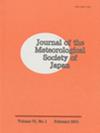日本强降雨区识别、分类及其特征特征
IF 1.6
4区 地球科学
Q3 METEOROLOGY & ATMOSPHERIC SCIENCES
引用次数: 11
摘要
我们提出了一种新的强降雨区(HRA)的客观识别和分类程序,以促进对日本中尺度对流系统(MCS)的理解。通过雷达/雨量计分析的降水量来评估累积降水量的分布,并检验HRA的特征特征。2009-2018年温暖季节(4-11月)提取的HRA根据其形态特征和时间变化分为四种类型(例如,线性平稳、线性、平稳等)。在日本东部和西部的太平洋两侧经常观察到HRA;80%的HRA出现在6月至9月,60%的HRA与固定锋和热带气旋有关。如先前的研究所示,线性静止型HRA中约80%对应于典型的伸长和停滞MCS。本文章由计算机程序翻译,如有差异,请以英文原文为准。
Identification and Classification of Heavy Rainfall Areas and their Characteristic Features in Japan
We propose a new procedure for the objective identification and classification of heavy rainfall areas (HRAs) to advance the understanding of mesoscale convective systems (MCSs) in Japan. The distributions of accumulated precipitation amounts are evaluated from the radar/raingauge-analyzed precipitation amounts and characteristic features of HRAs are examined. The HRAs extracted during the warm seasons (April–November) in 2009 – 2018 are classified into four types (e.g., linear-stationary, linear, stationary, and others) based on their morphological features and temporal variations. HRAs are frequently observed on the Pacific sides of eastern and western Japan; 80 % of HRAs appeared from June to September and 60 % of the HRAs were observed in association with stationary fronts and tropical cyclones. Approximately 80 % of those HRAs of the linear-stationary type corresponded to typical elongated and stagnated MCSs, as suggested in previous studies.
求助全文
通过发布文献求助,成功后即可免费获取论文全文。
去求助
来源期刊
CiteScore
6.70
自引率
16.10%
发文量
56
审稿时长
3 months
期刊介绍:
JMSJ publishes Articles and Notes and Correspondence that report novel scientific discoveries or technical developments that advance understanding in meteorology and related sciences. The journal’s broad scope includes meteorological observations, modeling, data assimilation, analyses, global and regional climate research, satellite remote sensing, chemistry and transport, and dynamic meteorology including geophysical fluid dynamics. In particular, JMSJ welcomes papers related to Asian monsoons, climate and mesoscale models, and numerical weather forecasts. Insightful and well-structured original Review Articles that describe the advances and challenges in meteorology and related sciences are also welcome.

 求助内容:
求助内容: 应助结果提醒方式:
应助结果提醒方式:


